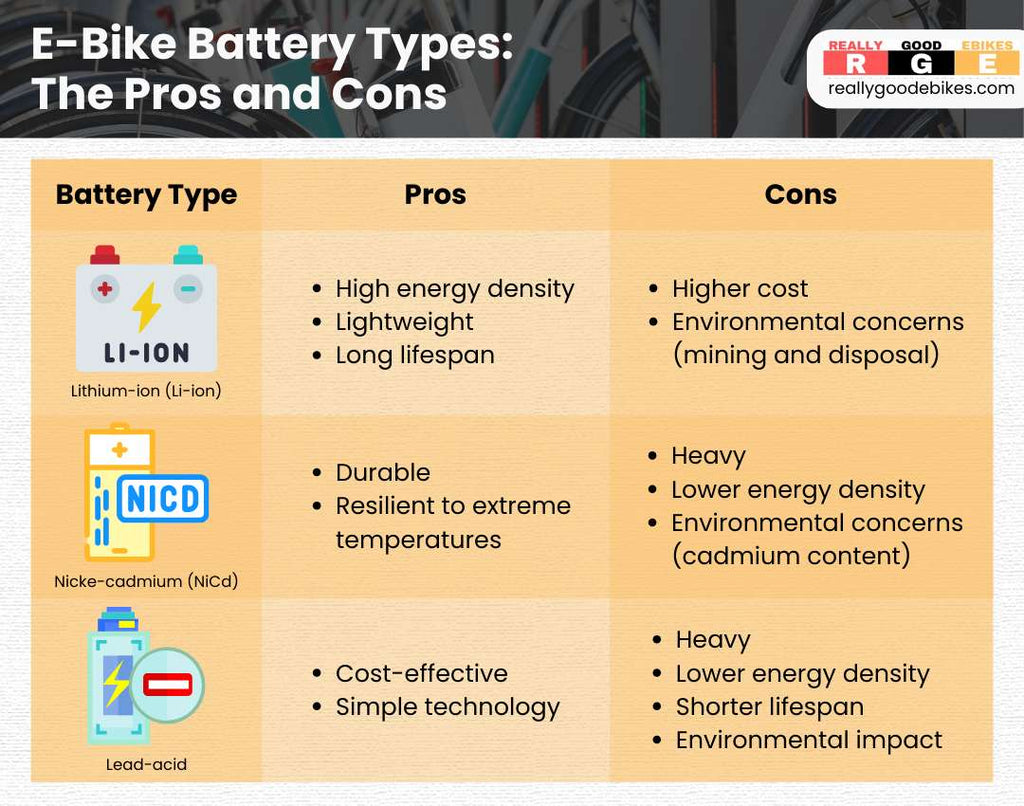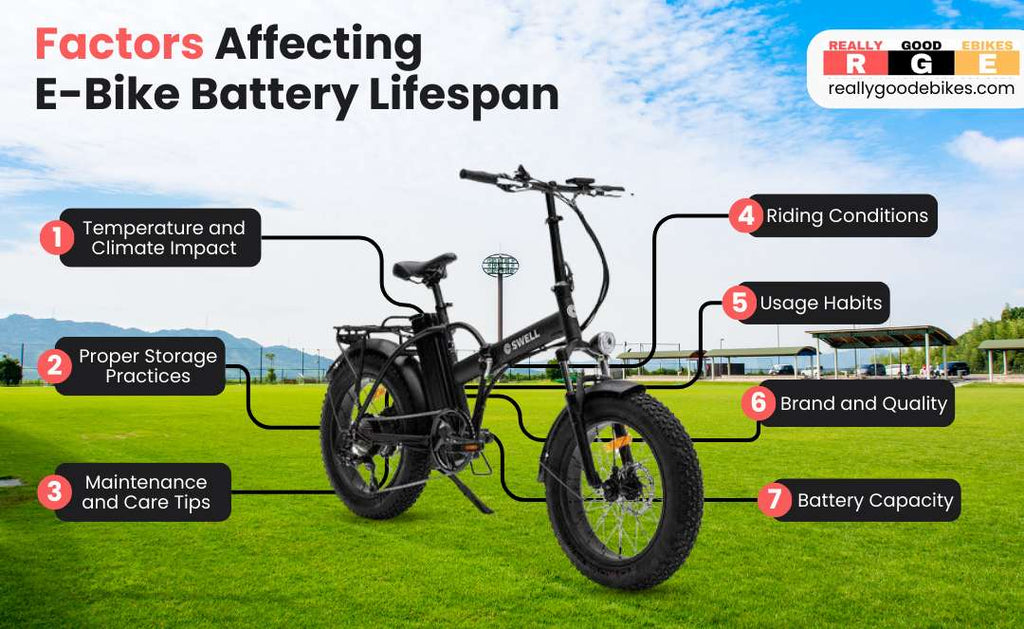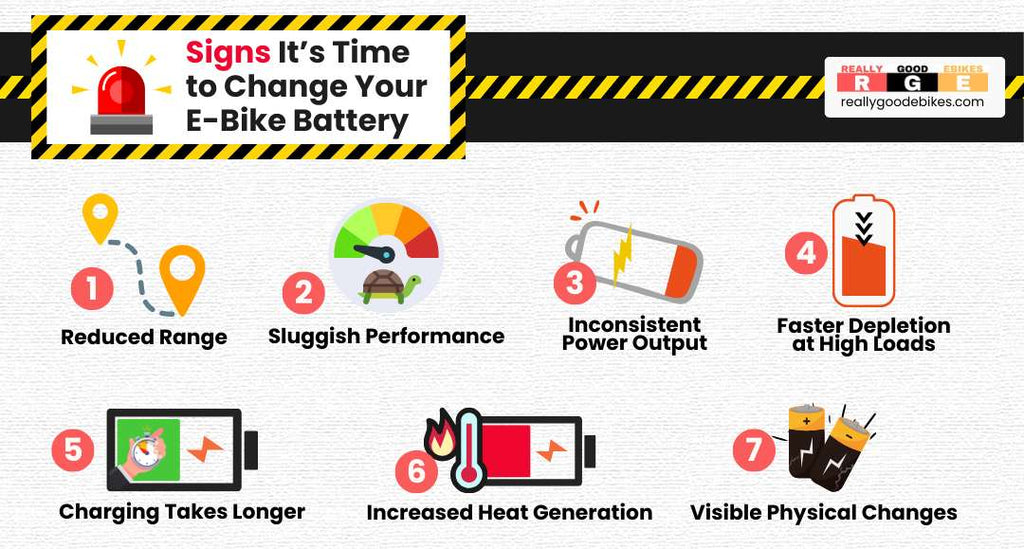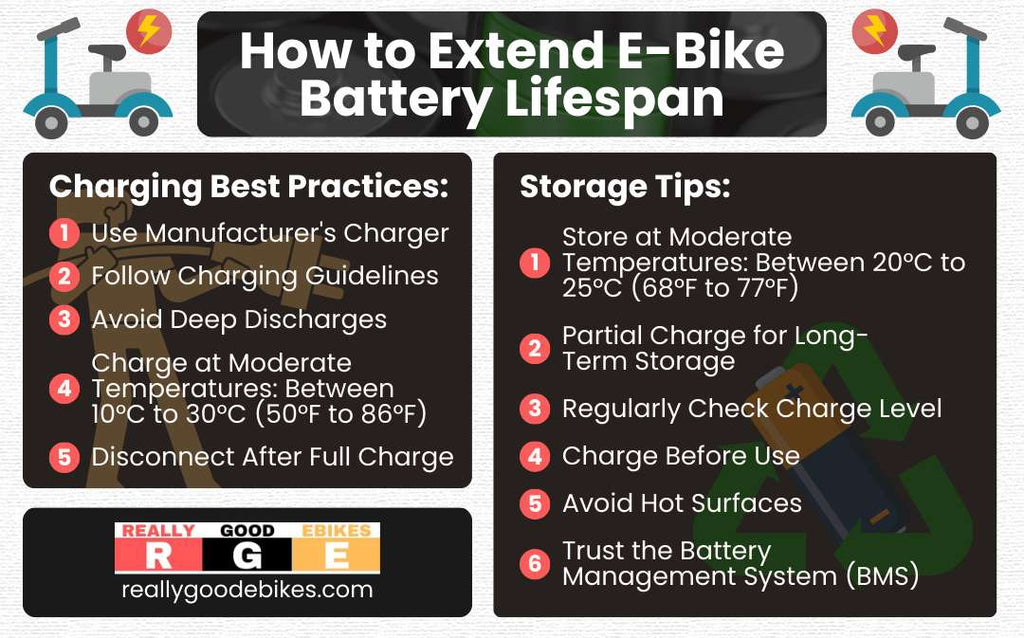Your Cart is Empty
Menu

How Long Does An E-Bike Battery Last?
February 21, 2024

Like the fuel that powers a car or the energy in your morning coffee, an e-bike battery is the lifeblood of your ride. It holds immense power and potential, just waiting to be unleashed. But how long can this mighty battery last? That's a question every e-biker asks at some point.
The lifespan of an e-bike battery typically ranges from 2 to 10 years, depending on factors such as usage patterns, charging habits, and the quality of the battery. On average, most e-bike batteries can last around 3 to 5 years with regular use.
In this article, we will explore the factors influencing an e-bike battery's lifespan and reveal how long it can endure before recharging. We'll also dive into techniques for monitoring battery health and extending its lifespan.
Understanding E-Bike Batteries
When it comes to understanding e-bike batteries and how long they last, there are two key points to consider. Firstly, the type of battery used in an e-bike plays a significant role in determining its lifespan. Secondly, several components can affect the overall battery life, such as the motor power, terrain conditions, rider weight, and usage patterns.
Types of E-Bike Batteries
E-bike batteries come in various types, each with its characteristics and advantages. The most common and widely used type is the Lithium-ion (Li-ion) battery.
Lithium-ion Batteries
Lithium-ion batteries are favored for their high energy density, lightweight construction, and long lifespan. They are commonly used in modern e-bikes due to their efficiency and ability to provide a significant range per charge. With the ability to provide a substantial range per charge, these batteries have become the industry standard, combining reliability and performance for a superior riding experience.
Nickel-Cadmium Batteries
Nickel-cadmium (NiCd) batteries, although less common in contemporary e-bikes, were once popular for their durability and resilience to extreme temperatures. However, the rise of Lithium-ion technology has overshadowed NiCd batteries due to their heavier weight, lower energy density, and environmental concerns associated with cadmium. Modern e-bikes mostly opt for Lithium-ion batteries, emphasizing efficiency and sustainability.
Lead-acid Batteries
While less prevalent in today's e-bike landscape, lead-acid batteries remain a cost-effective option. These batteries are characterized by their lower energy density, shorter lifespan, and heavier build compared to Lithium-ion counterparts.
Lead-acid batteries are often found in older or budget-friendly electric bikes where cost considerations outweigh the desire for the lighter weight and longer lifespan offered by more advanced battery technologies. As the industry continues to evolve, Lithium-ion batteries dominate, offering superior performance and efficiency for e-bike enthusiasts.
Here's a simple data table outlining the pros and cons of different e-bike battery types:

Components Affecting Battery Life
Regarding the components that affect battery life on an e-bike, two key factors are the battery management system (BMS) and charging cycles.
Battery Management System (BMS)
The battery management system (BMS) is crucial for optimizing the lifespan of an e-bike battery. It plays a vital role in monitoring and controlling battery performance, longevity, maintenance, efficiency, and technology.
The BMS ensures that the battery operates within safe limits by regulating factors such as charging rates, temperature, and voltage levels. By carefully managing these aspects, the BMS helps extend the overall lifespan of the e-bike battery while maximizing its efficiency and performance.
Charging Cycles
Charging cycles refer to the number of times you charge and discharge your battery. Each cycle contributes to the wear and tear of the battery, eventually leading to a decrease in its capacity.
By properly managing your charging cycles, you can extend the lifespan of your battery and delay the need for a replacement. It's important to note that charging time, battery maintenance, and following manufacturer guidelines also maximize battery efficiency and maintain its warranty.
Factors Influencing E-Bike Battery Lifespan
When it comes to the lifespan of your e-bike battery, there are several key factors to consider. First and foremost is the impact of temperature and climate. Extreme heat or cold can significantly affect your battery's performance and overall lifespan.

Temperature and Climate Impact
Remember that extreme temperatures and harsh climates can significantly affect the lifespan of your e-bike battery. The climate impact on battery performance is crucial to consider when maintaining optimal battery longevity.
High temperatures can cause the battery cells to degrade faster, reducing their overall capacity and lifespan. On the other hand, extremely cold temperatures can decrease the efficiency of the chemical reactions within the battery, leading to reduced power output and decreased range.
To ensure maximum battery longevity, storing your e-bike in a cool and dry place when not in use is recommended. Additionally, avoid exposing it to extreme temperatures for extended periods, such as leaving it outside during winter or under direct sunlight during summer.
Proper Storage Practices
For optimal results, ensure you find a cool and dry spot to store your e-bike, protecting it from extreme temperatures that can harm its longevity. Proper storage practices are crucial in maintaining battery health and extending its lifespan.
When storing your e-bike, ensure the battery is charged around 50%. This charge level helps prevent over-discharge during storage, which can negatively impact the battery's performance over time.
Removing the battery from the e-bike is also recommended for long-term storage. This prevents any potential power drain or damage caused by vibrations during transportation or handling.
Battery Capacity
Battery capacity refers to the amount of energy that a battery can store. This directly affects its performance and lifespan.
To optimize your battery capacity, it is essential to understand the latest advancements in battery technology. You should also know how they impact efficiency. Lithium-ion batteries are commonly used in e-bikes due to their high energy density and long cycle life.
However, there are also factors within your control that can affect battery capacity. These include proper charging techniques and regular maintenance. Avoid exposing your battery to extreme temperatures or deep discharges, as these can negatively impact its longevity.
Riding Conditions
Riding conditions play a crucial role in determining how long your e-bike battery will last before needing to be recharged. Factors such as terrain, weather, and rider weight can all affect the battery's performance.
The electric motor in an e-bike relies on energy from the battery to power your ride. When riding uphill or on rough terrain, the motor has to work harder, causing increased energy consumption and reducing the overall battery range. Similarly, unfavorable weather conditions like strong headwinds or extreme temperatures can also decrease battery efficiency.
To maximize your e-bike's battery performance, it's important to consider these factors when planning your rides. By choosing routes with gentle slopes and favorable weather conditions, you can optimize the lifespan of your e-bike battery and ensure a smooth and enjoyable ride for longer durations.
Usage Habits
You must develop good usage habits to ensure optimal performance and longevity of your e-bike battery.
First and foremost, understand the difference between electric and manual modes. While electric mode offers ease of use, it puts more strain on the battery than manual mode. Consider switching to manual mode when riding on flat terrain or during short trips to maximize battery life.
Additionally, proper battery maintenance is essential. Regularly check for any signs of damage or wear, such as corrosion or loose connections.
Remember that batteries have a limited lifespan, even with careful usage and maintenance.
Brand and Quality
When considering the brand and quality of an e-bike battery, it's important to focus on its lifespan, performance, durability, reliability, and longevity.
A high-quality battery will have a longer lifespan, allowing you to enjoy rides without worrying about frequent replacements. It will also provide consistent performance throughout its life, ensuring your e-bike runs smoothly.
Additionally, a durable and reliable battery can withstand various weather conditions and terrain types, giving you the confidence to explore different routes. It will retain its capacity over time, enabling you to maximize your riding experience.
Investing in a reputable brand with superior quality standards ensures that your e-bike battery meets all these criteria and provides a seamless riding experience for years to come.
Maintenance and Care Tips
To ensure your e-bike stays in top shape, it's important to maintain and care for it regularly.
Proper maintenance tips include charging the battery between 20% and 80% to maximize lifespan. Avoid exposing the battery to extreme temperatures, affecting its performance and longevity. It's also crucial to clean the battery regularly using a soft cloth and mild detergent to remove any dirt or grime that may accumulate over time.
Additionally, troubleshooting common issues such as sudden power loss or reduced range can be done by checking for loose connections and ensuring proper contact with the charger. If these issues persist, contacting a professional technician for assistance is recommended.
When maximizing battery life, there are some factors to consider. Using pedal-assist mode instead of relying solely on throttle power can help extend battery life. It's also advisable not to fully discharge the battery before recharging it.
If you find that your e-bike battery needs replacement, there are several options available. You can choose between original manufacturer batteries or aftermarket replacements that offer similar specifications at a lower cost.
In this video, let's look at some helpful tips that can help keep your e-bike battery in the best health.
So, How Long Does an E-Bike Battery Typically Last?
Typically, an e-bike battery lasts for around 3-5 years before it needs to be replaced. Understanding the efficiency of an e-bike battery is crucial in optimizing its lifespan.
To ensure your battery lasts as long as possible, it's important to charge it properly and avoid overcharging or discharging it completely. Regularly monitoring the battery's health and maintaining a consistent charging routine can help extend its lifespan.
Battery range estimation is another key aspect to consider when discussing how long an e-bike battery lasts. The range of an e-bike battery depends on various factors such as terrain, rider weight, and assist level used. Manufacturers typically provide estimates based on average conditions, but individual experiences may vary.
When purchasing an e-bike, it's essential to inquire about the battery warranty coverage offered by the manufacturer. Different brands have different warranty policies, so understanding what is covered and for how long can be beneficial in case any issues arise with the battery during its expected lifespan.
Additionally, many manufacturers now promote sustainable practices by offering recycling programs for old e-bike batteries.
While the average lifespan of an e-bike battery ranges from 3-5 years, understanding efficiency optimization techniques, considering range estimation factors, being aware of warranty coverage options, and participating in recycling initiatives can help maximize its longevity.
How to Monitor E-Bike Battery Health
Various tools and apps are available to monitor your e-bike battery's health. These tools and apps provide detailed information about your battery's current state, including its capacity, voltage, and charging cycles.
Tools and Apps for Monitoring Battery Health
You'll be amazed at the wide array of tools and apps available to keep an eye on your e-bike battery's health. Battery monitoring is made easy with these innovative solutions that offer real-time insights into your battery's performance.
Generic e-bike monitoring apps such as EBike Connect provide real-time data on battery status and range estimation for various systems. Third-party apps like MyEnergi Platform or battery level indicator apps like Battery Life for iOS offer compatibility with diverse e-bike systems.
With battery diagnostics, you can also uncover potential issues or anomalies before they become major problems. Battery tracking allows you to monitor your battery's overall lifespan, giving you a clear understanding of when it might need replacement.
Additionally, these tools provide valuable data on battery performance, helping you optimize its usage and maximize its lifespan. Whether through detailed graphs and charts or personalized notifications, these tools ensure you never have to worry about your e-bike battery's health again.
Signs of a Declining E-Bike Battery

One clear indication that your e-bike battery is starting to decline is when it no longer holds a charge for as long as it used to. This decrease in battery performance can be attributed to factors such as battery degradation and capacity loss over time.
As the battery goes through charging cycles, its ability to store energy gradually diminishes. Monitoring these signs of declining battery health is important because they can affect your overall riding experience. Using tools and apps designed for monitoring battery health, you can estimate the remaining lifespan of your e-bike battery and determine when it may need replacement.
Extending E-Bike Battery Lifespan
To extend the lifespan of your e-bike battery, it's important to follow charging best practices.

Charging Best Practices
There are several best practices to follow to maximize charging efficiency and optimize battery lifespan.
First, always use the charger specifically designed for your e-bike model. Using the wrong charger can lead to overcharging risks and potentially damage the battery cells.
Additionally, avoid leaving your e-bike connected to the charger for extended periods after reaching full charge, as this can shorten the battery's lifespan. It's recommended to unplug the charger promptly once charging is complete.
Furthermore, regular battery maintenance is crucial for optimal performance and longevity. This includes keeping the contacts clean and periodically checking for any signs of wear or damage.
Storage Tips for Prolonged Periods of Inactivity
If you want to keep your e-bike battery in top condition during periods of inactivity, here's a handy storage tip.
Proper maintenance and storage are essential for preventing battery degradation and ensuring longevity. To preserve your battery, start charging it to around 50% before storing it. This helps prevent over-discharge or overcharging during prolonged periods of inactivity.
It's also important to store the battery in a cool, dry place away from direct sunlight or extreme temperatures. Avoid exposing it to moisture or placing heavy objects on top of it, as this can damage the cells inside.
Additionally, check the battery regularly and recharge it every few months to maintain optimal performance.
Comparison with Other Transportation Modes
Compared to other transportation modes, an e-bike battery lasts significantly longer and will empower you to explore without worrying about running out of power.
When comparing e-bikes with cars, it's clear that e-bike batteries have a distinct advantage. While a car typically requires frequent refueling or recharging after covering a certain distance, an e-bike battery can provide hours of continuous use before recharging.
One of the key benefits of e-bike batteries is their extended range. With technological advancements, modern e-bikes can travel up to 100 miles on a single charge, depending on terrain and rider weight. This impressive range eliminates the dreaded 'range anxiety' often associated with electric vehicles.
Furthermore, e-bike batteries offer significant environmental advantages over cars. They produce zero emissions during operation, reducing air pollution and contributing to cleaner cities. Additionally, the energy required to charge an e-bike battery is far less than what is needed for a car, making it more cost-effective in the long run.
In terms of cost-effectiveness, using an e-bike as your primary mode of transportation can save you money on fuel costs and maintenance compared to owning and maintaining a car. E-bikes require minimal upkeep and are generally more affordable than automobiles.
Future Developments in E-Bike Batteries

The future of e-bike batteries holds endless possibilities for innovation and improvement. One area of focus for future developments is enhancing battery technology to improve energy efficiency.
Manufacturers constantly strive to create batteries that can store more energy while consuming less power. This will not only extend the range of your e-bike but also make it more sustainable and environmentally friendly.
Another aspect being explored is increasing power density in e-bike batteries. By packing more energy into a smaller space, manufacturers aim to reduce the battery's overall weight without compromising its performance. This would result in lighter e-bikes that are easier to handle and maneuver.
Furthermore, advancements in charging infrastructure are also being considered. As more people adopt e-bikes as their primary mode of transportation, there is a need for convenient and efficient charging solutions. Companies are developing faster charging technologies and expanding the network of charging stations to ensure you can easily recharge your battery whenever needed.
The future of e-bike battery technology looks promising, with ongoing research and development focusing on future innovations such as enhanced energy efficiency, increased power density, and improved charging infrastructure. These advancements will enhance your riding experience by providing longer ranges, greater power, and seamless recharging options while contributing to a greener environment.
Sustainable Rides: E-Bike Battery Lifespan Unveiled
In conclusion, your e-bike battery is like the life force that fuels your ride. It has the power to take you on countless adventures and journeys. However, just like any other energy source, its lifespan can be influenced by various factors.
By understanding how long an e-bike battery lasts and taking steps to monitor and extend its health, you can ensure a longer-lasting and more efficient ride. As advancements continue in e-bike technology, we can expect even greater improvements in battery longevity for a future of limitless possibilities.
Leave a comment
Comments will be approved before showing up.
Also in Really Good Ebikes: Electric Bike Blog

The Best Electric Bikes for RVers: A 2024 In-depth Review
April 02, 2024
Discover the best electric bikes for RVers in our comprehensive 2024 review. From foldable designs to long-range capabilities, find the perfect ride for your next adventure.
Read More x

